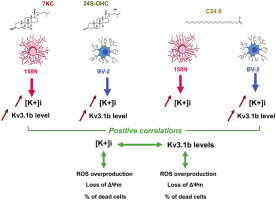Biochimie ( IF 3.9 ) Pub Date : 2018-02-17 , DOI: 10.1016/j.biochi.2018.02.008 Maryem Bezine , Sonia Maatoug , Rym Ben Khalifa , Meryam Debbabi , Amira Zarrouk , Yuqin Wang , William J. Griffiths , Thomas Nury , Mohammad Samadi , Anne Vejux , Jérôme de Sèze , Thibault Moreau , Riadh Kharrat , Mohamed El Ayeb , Gérard Lizard

|
Little is known about K+ regulation playing major roles in the propagation of nerve impulses, as well as in apoptosis and inflammasome activation involved in neurodegeneration. As increased levels of 7-ketocholesterol (7KC), 24S-hydroxycholesterol (24S-OHC) and tetracosanoic acid (C24:0) have been observed in patients with neurodegenerative diseases, we studied the effect of 24 and/or 48 h of treatment with 7KC, 24S-OHC and C24:0 on Kv3.1b potassium channel level, intracellular K+ concentration, oxidative stress, mitochondrial dysfunction, and plasma membrane permeability in 158N oligodendrocytes and BV-2 microglial cells. In 158N cells, whereas increased level of Kv3.1b was only observed with 7KC and 24S-OHC but not with C24:0 at 24 h, an intracellular accumulation of K+ was always detected. In BV-2 cells treated with 7KC, 24S-OHC and C24:0, Kv3.1b level was only increased at 48 h; intracellular K+ accumulation was found at 24 h with 7KC, 24S-OHC and C24:0, and only with C24:0 at 48 h. Positive correlations between Kv3.1b level and intracellular K+ concentration were observed in 158N cells in the presence of 7KC and 24S-OHC, and in 7KC-treated BV-2 cells at 48 h. Positive correlations were also found between Kv3.1b or the intracellular K+ concentration, overproduction of reactive oxygen species, loss of transmembrane mitochondrial potential and increased plasma membrane permeability in 158N and BV-2 cells. Our data support that the lipid environment affects Kv3.1b channel expression and/or functionality, and that the subsequent rupture of K+ homeostasis is relied with oligodendrocytes and microglial cells damages.
中文翻译:

用7-酮胆固醇,24S-羟基胆固醇或十四烷酸(C24:0)处理的158N鼠少突胶质细胞和BV-2鼠小胶质细胞中Kv3.1b钾通道水平和细胞内钾浓度的调节
关于K +调节在神经冲动的传播,以及神经变性涉及的凋亡和炎症小体活化中起主要作用的了解甚少。由于在神经退行性疾病患者中观察到7-酮胆固醇(7KC),24S-羟基胆固醇(24S-OHC)和四癸酸(C24:0)的水平升高,因此我们研究了24和/或48 h的神经退行性疾病治疗的效果在158N少突胶质细胞和BV-2小胶质细胞中,Kv3.1b钾通道水平,细胞内K +浓度,氧化应激,线粒体功能障碍和质膜通透性分别为7KC,24S-OHC和C24:0 。在158N细胞,而增加Kv3.1b的水平仅与7KC和24S-OHC但不与C24观察到:0在第24小时,K的细胞内积聚+始终被检测到。在用7KC,24S-OHC和C24:0处理的BV-2细胞中,Kv3.1b水平仅在48 h时升高;7KC,24S-OHC和C24:0在24 h时发现细胞内K +积累,而在48 h仅在C24:0时发现。在存在7KC和24S-OHC的情况下,在158N细胞中以及在48 h处理7KC的BV-2细胞中,观察到Kv3.1b水平与细胞内K +浓度之间呈正相关。在Kv3.1b或细胞内K +之间也发现正相关158N和BV-2细胞的浓度,活性氧的过量生产,跨膜线粒体电位的丧失和质膜通透性的增加。我们的数据支持脂质环境影响Kv3.1b通道的表达和/或功能,并且随后的K +稳态破裂取决于少突胶质细胞和小胶质细胞的损害。


























 京公网安备 11010802027423号
京公网安备 11010802027423号